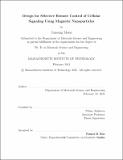Design for selective remote control of cellular signaling using magnetic nanoparticles
Author(s)
Moon, Junsang.
Download1251770341-MIT.pdf (26.92Mb)
Other Contributors
Massachusetts Institute of Technology. Department of Materials Science and Engineering.
Advisor
Polina Anikeeva.
Terms of use
Metadata
Show full item recordAbstract
Understanding the structure and dynamics of the mammalian cellular signaling and the nervous system opens up the chances to induce tissues, organs, or organisms to function in a coordinated way. Consequently, extensive research and efforts have rapidly developed strategies for rationally manipulating cellular and neuronal signaling. In this thesis, I pursued to develop a wirelessly modulating system that can selectively control a targeted biological circuit. Heat dissipating properties of magnetic nanoparticles have garnered sustained research interest in biomedical applications, including drug release, cancer hyperthermia, and neural stimulations. However, research has been mainly focused on improving the magnetic nanomaterials' heat dissipation efficiency. To introduce selective heat dissipation of magnetic nanoparticles, I have designed a custom AC magnetometer that can capture dynamic magnetization of magnetic particles suspended in solution. The collected magnetic response data fed to an equation called multiplexing factor to find optimized alternative magnetic field conditions that can selectively trigger heat dissipation on each particle ensemble. This approach was confirmed by direct temperature change observation using a thermographic camera. The selective heating system was later combined with genetic engineering and a drug delivery system for selective cellular modulation. This work culminates in a demonstration of selective remote control of cellular signaling in vitro. The theoretical background, systematic design, and precisely executed demonstration can be transplanted to any system using magnetic nanoparticles as a heat transducer. Therefore, this study will set a strong foundation and suggest new approaches for researches utilizing magnetic nanoparticle's heat dissipation for any applications.
Description
Thesis: Ph. D., Massachusetts Institute of Technology, Department of Materials Science and Engineering, February, 2021 Cataloged from the official PDF of thesis. Includes bibliographical references (pages 137-147).
Date issued
2021Department
Massachusetts Institute of Technology. Department of Materials Science and EngineeringPublisher
Massachusetts Institute of Technology
Keywords
Materials Science and Engineering.